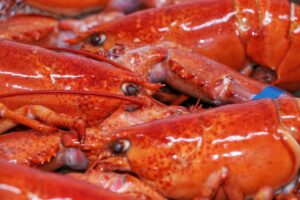Increasing the Value of the American Lobster Fishery by Improving Shell Quality and Meat Yield
Funding sources: Ready Seafood Co. and Maine Technology Asset Fund
Investigators:
Richard A. Wahle, University of Maine, School of Marine Sciences
Joshua Stoll, University of Maine, School of Marine Sciences
Steven Jury, St. Joseph’s College, School of Biology
Student Investigators:
Nicole Orminski, University of Maine, School of Marine Sciences
Industry Partners:
Curtis Brown (Ready Seafood Co., Portland, ME)
The American lobster fishery is the most valuable fishery in the US. More than half of the US harvest is exported, and a growing percentage has been going to China, however, Asian demand has lowered due to a recent 25% tariff on US lobster products. This lower demand coupled with decreasing supply underscore the need for new ways to add value to lobster products. There are two key determinants of value of a harvested lobster: (1) shell hardness, as an indicator of viability, which determines how far it can be shipped, and (2) meat yield, which determines its value as a processed product. The better the shell hardness or meat yield, the higher the value.
The proposed project aims to evaluate how lobster shell quality and meat yield can be improved in large scale environmentally controlled holding facilities on relatively short time scales during the summer when the supply of low-value, soft-shell lobsters is high. This project will shed light on the feasibility and profitability of holding relatively low value lobsters for short periods to improve their quality enough to divert them from lower value domestic markets to higher value international markets.
Objective 1-Maximize Value
We aim to use Ready Seafood Co’s new environmentally controlled lobster holding facility to find the optimum temperature, salinity and starting shell grade to minimize the time needed to improve lobster shell quality and yield, and maximize profitability.
Objective 2 -Economic Analysis and Industry Outreach
We will conduct an economic impact study of our results and communicate results and perspectives to provide harvesters useful ways to increase the value of their own catch.

